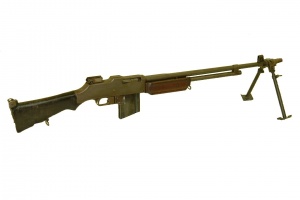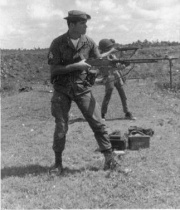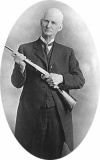Difference between revisions of "M1918 Browning Automatic Rifle"
(→See also) |
m (1 revision) |
Latest revision as of 16:52, 15 March 2013
| |||||||||||||||||||||||||||||||||||||||||||||||||||||||||||
- Not to be confused with the semi-automatic Browning BAR
The Browning Automatic Rifle (more formally designated first as the Rifle, Caliber .30, Automatic, Browning, M1918 and later the Browning Automatic Rifle, Caliber .30, M1918A2; and commonly known as the BAR), is a family of automatic rifles (or machine rifles) and light machine guns used by the United States and other countries during the 20th century.
It was designed in 1917 by the weapons designer John Browning, primarily as a replacement for (and improvement on) the French-made Chauchat and Hotchkiss M1909. The BAR was originally intended as a light automatic rifle, but spent much of its career in various guises used in the light machine gun role with a bipod. The original M1918 version was and remains the lightest service machine gun to fire the .30-06 Springfield cartridge, though the limited capacity of its standard 20-round magazine tended to hamper its utility as a light machine gun.
Contents[hide] |
[edit] History and design
The BAR is a gas-operated, air-cooled, magazine-fed automatic rifle that fires from an open bolt. Built for the U.S. military, the BAR was chambered for the standard .30-06 Springfield service round. The rifle weighed between 16 and 19 pounds (7.3 to 8.6 kg) empty, depending upon the model. The barrel is screwed into the receiver and is not quickly detachable. The magazine was a 20 round detachable box, though a 40-round version was briefly issued for anti-aircraft use.
From its inception, the BAR M1918 was an automatic rifle. First issued end of September 1918 to the AEF, it was based on the concept of "walking fire" a French practise in use since 1916 for which the CSRG 1915 had been used in an automatic weapon accompanying advancing squads of riflemen toward the enemy trenches since the machine guns were too heavy to follow the troops during an assault. In addition to shoulder-fired operation, BAR gunners were issued a belt with magazine pouches for the BAR and sidearm along with a "cup" to support the stock of the rifle when held at the hip. In theory, this allowed the soldier to lay suppressive fire while walking forward, keeping the enemy's head down until it was too late. (The idea would resurface in the submachine gun and ultimately the assault rifle.) It is not known if any of these belt-cup devices actually saw combat use. The BAR saw little action in WWI, in part due to the Armistice, in part because the U.S. Army was reluctant to have the BAR fall into enemy hands, its first action being in September of 1918. Eighty-five thousand BARs were built by the war's end.
In 1922, the M1922 BAR was introduced. This version was equipped with a flanged or finned barrel and side-mounted sling swivel, and was intended for use by the U.S. Cavalry. The M1922 had no bipod as issued, although one could be fitted if desired. In terms of designation, a slight difference in terminology existed as to the M1922, which was termed a "machine rifle", as opposed to an "automatic rifle" or "machine gun". In June 1937, a small number of M1918s were modified to include a spiked bipod attached to the gas cylinder and a hinged buttplate. These weapons were designated M1918A1.
In the 1930s a polish variant was licenced and used by the polish military as an LMG in limited numbers. The polish variant was produced by Vis and sported a pistolgrip as well as the original stock. The Polish BAR was chambered in several calibers including 7.92 x 57 for use of surplus German ammunition.
In 1940, the final BAR model—the M1918A2—was introduced. This model did away with the semi-automatic fire option in favor of fully automatic fire only. The rate of fire was adjustable, with a choice between "fast-auto" (500–650 round/min) and "slow-auto" (300–450 round/min). This was accomplished by the use of a highly complicated recoil buffer mechanism that was difficult to clean, and often proved susceptible in service to damage from moisture and corrosion, often rendering the weapon inoperable. The (unspiked) bipod was now attached to the barrel, a flash hider was added, a rear monopod was hinged to the butt, and the weapon's role was changed to that of a squad light machinegun. Its success in this role was mixed at best, since the BAR's fixed non-replaceable barrel and small magazine capacity greatly limited its utility in comparison to genuine light machineguns such as the Bren or the Japanese Type 96. The bipod and flashhider, being easily removable, were often discarded by troops to save weight and improve the portability of the BAR. In combat, particularly in the Pacific theatre of war, the BAR effectively reverted to its original role as a portable, shoulder-fired automatic rifle. In 1942, a fiberglass buttstock replaced the wood version, and late in the war, a barrel-mounted carrying handle was added.
Issued as the heavy fire support for a squad, all men were trained at the basic level how to operate and fire the BAR in case the man carrying it was out of action. While not without its design flaws (a thin-diameter, fixed barrel that quickly overheated, limited magazine capacity, complex field-strip/cleaning procedure, unreliable recoil buffer mechanism, a gas cylinder assembly made of corrosion-prone metals, and many small internal parts), the basic BAR design nevertheless proved itself when kept clean and earned a reputation as being rugged and reliable. It served as a frontline standard weapon from the latter days of World War I through World War II, and was pressed into use in the Korean War as well. The BAR was also used in the early stages of the Vietnam War, when the U.S. passed a quantity to the South Vietnamese. Quantities of the BAR remained in use by the Army National Guard up until the mid 1970s. Many nations in NATO and recipients of U.S. foreign aid adopted the BAR and used it into the 1990s. Poland (Browning wz.1928), Belgium (FN M1930) and Sweden (Kulsprutegevär m/21 and m/37) developed and issued BAR variants during the 1930s which had pistol grips and quick-change barrels.
On a side note, contrary to popular belief (generated by the WWII movies and other media), the BAR was used in small quantities in Europe. The BAR's saw the most action in the pacific as a S.A.W. and on rare occasion due to weight, misused as assault rifles. The BAR was produced under licence in Great Britain as well as a host of other locations. The British version was chambered in .303 Enfield and sported a spike-type Bipod.
It is very hard to locate a real issue BAR bayonet. They are spike type and have a slat on the top side as they attach to the bottom of the barrel in the conventional fashion. The BAR is difficult to run and fire in the first place. A bayonet would make this operation that much more difficult.
[edit] Civilian ownership
The BAR proved a popular civilian weapon in the U.S., although fully automatic models were greatly restricted in the 1930s, which made them much harder to own and transfer. Importation of machine guns for U.S. civilian transfer was banned in 1968, and U.S. production of machine guns for civilian transfer was banned in 1986. Transferable civilian-owned BAR models remain, however.
Clyde Barrow of Bonnie and Clyde used a shortened BAR (stolen from National Guard armories) during his spree in the 1930s. The six lawmen who killed Bonnie and Clyde also used a variant of the BAR called the Monitor in their ambush.
A modern manufacturer of firearms has produced a semi-automatic version of the Browning Automatic Rifle known as the 1918A3 SLR ("self-loading rifle").[1]
The 'BAR' hunting rifle currently offered by Browning is a completely different firearm, unrelated in design to the Browning military weapons.
[edit] Variants
[edit] United States
[edit] M1918
- Initial model fielded during WWI and the inter-war period
[edit] M1918A1
- Produced in 1937 by modifying M1918
- Attached bipod
- Heavier barrel
[edit] M1918A2
- Produced from 1940 onwards
- Detachable bipod
- Fully automatic, with "slow" (300–450 round/min) and "fast" (500–650 round/min) rates of fire
- Late-war models switched to plastic stock
- Predominant model of all BAR variants
- Heavier barrel
[edit] M1922
- Bipod and stock-mounted rear monopod
- Heavier barrel with small cooling fins
- Light machine gun version
[edit] International
[edit] Browning wz.1928
- Main article: Browning wz.1928
- A variant of the M1918 BAR produced by Fabrique Nationale (FN) in Belgium to Polish requirements prior to WWII. License-produced in Poland.
- Chambered for the 7.92x57mm Mauser.
- Used a pistol grip rather than the conventional rifle stock grip.
[edit] FN M1930
- Variant produced by FN for Belgian military, chambered for the 7.92x57mm cartridge and featuring a pistol grip. FN also produced a subvariant with a quick-change barrel referred to as the Type D. See FN BAR.
[edit] Kulsprutegevär m/21 and m/37
Kulsprutegevär m/21 (Kg m/21) were M1918 BARs built in the US to Swedish specifications; the main differences to the M1918 were the detachable pistol grip, spiked bipod and use of the 6.5x55mm Swedish Mauser round. Initially produced by Colt, and then under license by Carl Gustafs Stads Gevärsfaktori in Eskilstuna, Sweden. The Kulsprutegevär m/37 variant, introduced in 1937, added a quick-change barrel and was in use by the Swedish Armed Forces until the 1970s.
[edit] BAR in .303 British
- Not much is known about the BAR in British Service, but some chambered in the .303 British round were believed to have been used by the Home Guard.
[edit] Commercial
[edit] Colt Automatic Machine Rifle
- Commercial variant made by Colt in several versions between the 1920s and the beginning of WWII, for civilian and law enforcement markets.
- One variant, the R80 Monitor, featured an 18-inch (460 mm) barrel, a lightweight receiver, and an ejection port cover along with a Cutts compensator.
[edit] Ohio Ordnance Works 1918A3 SLR
- The 1918A3 SLR (self-loading rifle) is a modern semi-automatic commercial version of the BAR aimed at the civilian market. The "1918A3" designation is not a military type-classification.
[edit] Barrow Scattergun
- The 'Scattergun' was a customized M1918 BAR with the barrel chopped shorter and sometimes the stock sawed off. This variant was customized by the Bonnie and Clyde gang.[1]
[edit] Citations
[edit] Resources
- Dunlap, Roy F., Ordnance Went Up Front, Samworth Press, 1948.
- Hogg, Ian V. and Weeks, John, Military Small Arms of the 20th Century, DBI Books Inc.
- FM 23–15: Basic Field Manual — Browning Automatic Rifle, Caliber .30, M1918A2 (30 June 1943)
[edit] External links
- Modern Firearms
- The BAR-family in Sweden
- 90th Infantry Division Preservation Group - Reference manual page including 4 BAR manuals
- WW2DB: Browning Automatic Rifle 'BAR'
[edit] See also
| [show]This article is part of a series on the works of John Moses Browning |
|---|
|
- John Browning
- Pages locked due to spam
- Pages locked due to spam until June 2011
- American 7.62mm light machine guns
- American .30-06 light machine guns
- American 7.62mm automatic rifles
- American .30-06 automatic rifles
- Browning 7.62mm light machine guns
- Browning .30-06 light machine guns
- Browning 7.62mm automatic rifles
- Browning .30-06 automatic rifles






